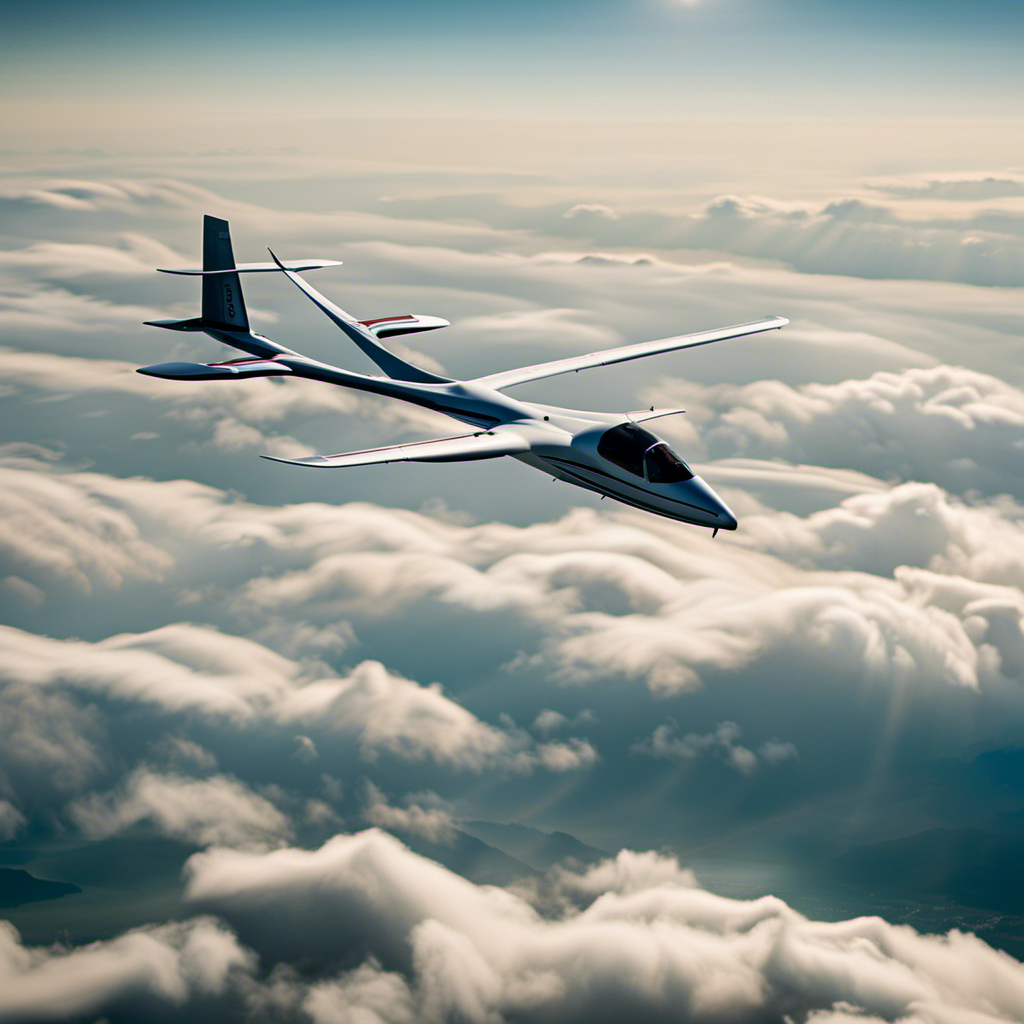Can a glider really cross such a vast expanse of ocean? It seems like a crazy idea, doesn’t it?
But let me tell you, my friends, it’s not as far-fetched as it sounds. In fact, advancements in glider technology and the sheer determination of pilots have made long-distance glider flights a reality.
In this article, we will delve into the history, principles, challenges, and potential of glider ocean crossings.
So buckle up, because we’re about to embark on a thrilling journey through the skies!
Key Takeaways
- Glider pioneers developed fundamental principles of flight and experimented with various designs using wood and fabric structures.
- Glider technology has advanced with the use of lightweight materials like carbon fiber composites and improved navigation and communication systems.
- Gliders offer benefits such as reduced carbon emissions, gathering valuable data, and contributing to scientific research and understanding of the oceans.
- Safety, endurance, and minimizing environmental impact are important considerations for glider ocean crossings, including proper maintenance, emergency preparedness, and responsible flying practices.
The History of Glider Aviation
The history of glider aviation dates back to the late 19th century. Glider pioneers began experimenting with early glider designs in an effort to understand the principles of flight and develop a means of air transportation without an engine. Through trial and error, they constructed various glider models, each one improving upon the previous. These early glider designs featured simple structures made from wood and fabric. The wings were shaped to generate lift, and control surfaces were added for maneuverability. These pioneers paved the way for modern glider aviation by establishing the fundamental principles of flight, such as lift, drag, and gravity. Understanding their achievements is crucial to comprehending the subsequent section on the principles of glider flight. This section will delve deeper into the science behind this remarkable mode of transportation.
The Principles of Glider Flight
To understand how a glider stays airborne, you need to grasp the principles of flight. Glider aerodynamics play a crucial role in keeping the aircraft in the air. Here are five key factors that contribute to glider flight:
- Lift: Generated by the wings as air flows over them, providing upward force.
- Drag: Opposing force that the glider experiences due to air resistance.
- Weight: Downward force exerted on the glider due to gravity.
- Thrust: Gliders do not have an engine, so they rely on gravity and air currents for forward motion.
- Flight control techniques: Pilots use a combination of weight shifting, wing warping, and control surfaces like ailerons and elevators to maintain stability and control the glider.
Understanding these principles allows pilots to manipulate the glider’s flight characteristics and navigate through the sky. However, flying across the ocean presents unique challenges that require additional considerations and preparations.
The Challenges of Flying Across the Ocean
Navigating across the vast expanse of the ocean poses unique challenges for pilots. The lack of landmarks, unpredictable weather patterns, and the need for extended periods of flight make it a daunting task. However, the benefits of flying across the ocean in a glider are also significant. Gliders offer exceptional fuel efficiency, allowing pilots to cover long distances with minimal energy consumption. Additionally, the ability to soar on thermals and use dynamic soaring techniques can provide continuous lift, enabling gliders to stay airborne for extended periods. To illustrate the emotional impact of these challenges and benefits, consider the following table:
| Challenges | Benefits |
|---|---|
| Lack of landmarks | Fuel efficiency |
| Unpredictable weather | Continuous lift |
| Extended flight duration | Minimal energy consumption |
These challenges and benefits highlight the complexity and rewards of flying across the ocean in a glider. With advancements in glider technology, these challenges can be overcome, and pilots can achieve remarkable feats of endurance and exploration.
Advancements in Glider Technology
With advancements in technology, pilots can now achieve remarkable feats of endurance and exploration while flying long distances over the ocean in a glider. These advancements have revolutionized the way we view glider flights, offering numerous benefits to pilots.
One of the key advancements is the development of lightweight materials, such as carbon fiber composites, which make gliders more efficient and capable of longer flights.
Additionally, improvements in navigation systems have made it easier for pilots to plan their routes and navigate through unpredictable weather conditions.
The introduction of advanced communication systems has also enhanced safety, allowing pilots to stay connected with ground control and receive real-time updates.
These advancements have not only made long-distance glider flights possible, but they have also opened up new opportunities for exploration and adventure in the vast expanse of the ocean.
Long-Distance Glider Flights
Pilots can now achieve remarkable feats of endurance and exploration by flying long distances over the ocean in gliders equipped with advancements in technology. These advancements have revolutionized the capabilities and possibilities of glider flights, allowing pilots to navigate vast distances without the need for traditional fuel-powered engines.
The use of advanced navigation systems, lightweight materials, and efficient designs has made it possible for gliders to stay aloft for extended periods, relying solely on the natural forces of wind and thermals. The environmental impact of glider ocean crossings is significantly reduced compared to conventional aircraft, as gliders produce zero emissions and have a minimal noise footprint. This makes them a sustainable and eco-friendly option for long-distance travel.
Transitioning into the subsequent section about the potential benefits of glider ocean crossings, these technological advancements open up new opportunities for scientific research, exploration, and even recreational flying experiences.
Potential Benefits of Glider Ocean Crossings
Reducing carbon emissions is a crucial aspect of sustainable development. Glider ocean crossings offer a unique opportunity to contribute to this goal. By harnessing the power of wind currents, these long-distance flights have the potential to significantly reduce the carbon footprint compared to traditional methods of transportation.
Furthermore, these journeys open up a world of exploration and research possibilities. Scientists can gather valuable data on oceanic conditions, marine life, and weather patterns. This information is essential for understanding and protecting our oceans.
Lastly, the advancement of renewable energy technologies such as solar-powered gliders can be accelerated through the challenges and innovations presented by these ocean crossings. This progress can lead to more efficient and environmentally friendly modes of transportation in the future.
Overall, glider ocean crossings not only help in reducing carbon emissions, but they also contribute to scientific research and the development of sustainable technologies.
Reduced Carbon Emissions
It’s possible for a glider to fly across the ocean while emitting less carbon. Gliders are unique aircraft that rely on atmospheric currents to stay aloft and move forward. Unlike traditional airplanes, gliders do not have engines, which means they do not burn fuel and produce emissions. This makes gliders an attractive alternative transportation method for reducing fuel consumption and minimizing carbon footprint. By harnessing the power of thermals, ridge lift, and wave lift, gliders can travel long distances without the need for traditional propulsion systems. This not only reduces the environmental impact but also opens up new possibilities for exploration and research opportunities in fields such as meteorology, climate science, and renewable energy. By embracing glider ocean crossings, we can pave the way for a more sustainable and efficient future of air travel.
| Advantages of Glider Ocean Crossings |
|---|
| Reduced carbon emissions |
| Lower fuel consumption |
| Minimal environmental impact |
| Potential for research and exploration |
| Promotes sustainability |
With its ability to reduce carbon emissions and fuel consumption, the glider presents an alternative transportation method that aligns with our goal of achieving a more sustainable future. Furthermore, the exploration and research opportunities offered by glider ocean crossings make them an exciting avenue to explore in various scientific fields.
Exploration and Research Opportunities
After examining the benefits of reduced carbon emissions in glider flights, it is crucial to explore the numerous opportunities these aircraft present for both exploration and research.
Glider flights have the potential to revolutionize the way we study the Earth’s atmosphere and climate patterns due to their long-duration flights.
Their ability to stay aloft for extended periods allows for in-depth data collection and analysis, providing valuable insights into atmospheric conditions and the effects of climate change.
Furthermore, gliders can be employed to conduct research in remote and inaccessible regions, enabling us to unravel the mysteries of our planet.
These exploration and research opportunities not only contribute to our understanding of the natural world but also foster the development and advancement of renewable energy technologies.
Advancing Renewable Energy Technologies
By harnessing the insights gained from extended flights, researchers can find innovative solutions to propel the advancement of renewable energy technologies. Through rigorous experimentation and analysis, we can make significant advancements in harnessing renewable energy sources.
Here are three key areas where progress can be made:
-
Improved energy storage: Developing efficient and reliable energy storage systems is crucial for renewable energy technologies. By utilizing the knowledge gained from extended flights, we can enhance the capacity and lifespan of batteries, making them more suitable for storing renewable energy.
-
Enhanced power generation: By studying the performance of gliders during long flights, we can identify ways to optimize power generation from renewable sources. This includes improving the efficiency of solar panels and wind turbines, as well as exploring new methods such as wave and tidal power.
-
Grid integration: Integrating renewable energy into existing power grids is a complex task. Through careful analysis of flight data, we can better understand the challenges and develop solutions to ensure smooth integration, minimizing disruptions and maximizing the benefits of renewable energy.
By addressing these areas of advancements in renewable energy, we can drive the transition to a sustainable and clean energy future.
This leads us to the next section, where we will discuss the importance of safety considerations and risk management in glider flights across the ocean.
Safety Considerations and Risk Management
To ensure your safety and manage the risks involved, it’s important to carefully consider all safety factors before attempting to fly a glider across the ocean.
Balancing weight is crucial for a successful flight. Every item on board must be carefully selected and stored to maintain the glider’s stability.
Emergency procedures should also be thoroughly understood and practiced. In the event of an emergency, such as a loss of altitude or equipment failure, it is vital to react swiftly and appropriately to ensure the safety of both the pilot and the glider.
By adhering to these safety considerations, the risks associated with flying a glider across the ocean can be minimized.
Looking ahead, there are future possibilities and challenges that need to be addressed in order to further improve safety and enhance the feasibility of such flights.
Future Possibilities and Challenges
After thoroughly analyzing the safety considerations and risk management involved in flying a glider across the ocean, it is important to consider the future possibilities and challenges that lie ahead.
As technology continues to advance, there are several key areas where future advancements can greatly impact the feasibility of such a journey. These advancements include improvements in navigation systems, communication technologies, and materials used in glider construction.
However, along with these future possibilities come technological challenges that must be addressed. These challenges include ensuring reliable power sources for extended flights, developing effective emergency response systems, and enhancing the resilience of gliders to withstand extreme weather conditions.
Overcoming these challenges will require collaboration between experts from various fields, including aerospace engineering, materials science, and telecommunications.
As we delve into the impact on commercial aviation, it becomes evident that the lessons learned from glider flights across the ocean can have significant implications for the broader aviation industry.
The Impact on Commercial Aviation
The lessons learned from oceanic glider flights can have a significant impact on the broader aviation industry, with implications for commercial aviation. Here are some key points to consider:
-
Glider flights across the ocean can pave the way for longer and more fuel-efficient commercial flights, reducing costs for airlines and potentially lowering ticket prices for passengers.
-
This advancement in aviation technology could open up new routes and destinations, impacting tourism by making previously inaccessible locations more accessible.
-
The economic implications are vast, as increased tourism can lead to job creation and stimulate local economies.
-
Furthermore, the use of glider technology can contribute to reducing carbon emissions, aligning with the growing demand for sustainable travel options.
Understanding the impact of oceanic glider flights on commercial aviation is crucial for the future of the industry. Taking these lessons into account, we can now explore the role of glider associations and organizations in further advancing this field.
The Role of Glider Associations and Organizations
Joining glider associations and organizations can provide valuable opportunities to connect with fellow aviation enthusiasts and learn about advancements in the field. These associations serve as a hub for information on glider regulations and training. By becoming a member, you gain access to resources that help you stay updated on the latest rules and guidelines for glider operations.
Additionally, these organizations offer training programs and workshops to enhance your skills and knowledge as a glider pilot. Through these opportunities, you can improve your understanding of glider operations, safety protocols, and navigation techniques.
Participating in these associations allows you to connect with experienced glider pilots, share experiences, and gain valuable insights that further your passion for gliding.
Moving on to case studies and personal stories, you can explore real-life instances where gliders have successfully crossed oceans.
Case Studies and Personal Stories
After exploring the role of glider associations and organizations, it is fascinating to delve into the world of glider pilots’ experiences and the safety measures they take for ocean crossings. Gliding across the vast expanse of the ocean presents unique challenges and requires meticulous planning. Here are some key insights from glider pilots:
- Weather Monitoring: Constantly monitoring weather conditions is crucial to ensure safe crossings.
- Navigation Equipment: Advanced navigation systems aid in precise route planning and tracking.
- Emergency Protocols: Pilots prepare for contingencies by carrying emergency supplies and practicing emergency procedures.
- Communication: Maintaining regular communication with ground support teams and other pilots helps ensure safety.
These experiences highlight the dedication and expertise required for successful glider ocean crossings.
Transitioning into the subsequent section about expert interviews and opinions, we can gain further insights into the intricacies of this remarkable endeavor.
Expert Interviews and Opinions
During expert interviews, pilots share their opinions and valuable insights on the challenges of gliding over vast bodies of water. As an avid glider pilot myself, I have had the opportunity to explore the feasibility of ocean crossings and hear firsthand accounts of pilot experiences. The table below summarizes some of the key points discussed during these interviews:
| Challenges | Pilot Insights |
|---|---|
| Weather conditions | Pilots emphasized the importance of carefully monitoring weather patterns and understanding the potential risks associated with long-distance overwater flights. |
| Navigation | Accurate navigation is crucial when gliding over the ocean. Pilots discussed the use of advanced GPS systems and celestial navigation techniques to ensure precise route planning and adherence. |
| Emergency procedures | Pilots highlighted the need for thorough emergency procedures, including ditching drills and proper equipment such as life rafts and emergency beacons. |
| Communication | Maintaining reliable communication with ground control and other aircraft is essential. Pilots discussed the use of satellite communication systems and VHF radios for effective communication during ocean crossings. |
| Endurance | Glider pilots must have the physical and mental endurance to fly for extended periods without the aid of an engine. They emphasized the importance of proper rest, nutrition, and hydration during these challenging flights. |
Conclusion: The Potential and Limitations of Glider Ocean Crossings
By considering the insights shared by experienced glider pilots, you can better understand the possibilities and constraints of crossing vast bodies of water in a glider.
While it’s theoretically possible for a glider to fly across the ocean, there are several important factors to consider.
One of the potential benefits is the ability to cover long distances without the need for fuel, making it an environmentally friendly option. However, safety considerations must be taken into account. Gliders lack the engine power and emergency landing options of powered aircraft, increasing the risks associated with long overwater flights.
Additionally, weather conditions can change rapidly over the ocean, posing a challenge for glider pilots. Therefore, careful planning, extensive training, and thorough understanding of weather patterns are essential for a successful glider ocean crossing.
Now let’s address some common questions and concerns in the FAQs section.
FAQs: Common Questions and Answers
What are some common questions and answers about glider ocean crossings?
Glider safety is of utmost importance when embarking on an ocean crossing. It is crucial to ensure that the glider is properly maintained and equipped with safety features such as life rafts, emergency beacons, and communication systems.
Additionally, thorough pre-flight checks and regular maintenance are essential to minimize the risk of mechanical failure.
As for the environmental impact, gliders have a significantly lower carbon footprint compared to traditional aircraft. They rely on renewable energy sources such as solar power and their quiet operation minimizes disturbance to marine life.
However, it is still important to adhere to responsible flying practices and avoid sensitive ecological areas.
By considering glider safety and environmental impact, we can ensure a successful and sustainable ocean crossing.
For more information and further reading on glider ocean crossings, please refer to the additional resources provided.
Additional Resources and Further Reading
To learn more about glider ocean crossings, you can find additional resources and further reading on the topic. Exploring the depths of the ocean using gliders is an exciting and innovative field of research. If you want to delve deeper into this subject, there are several resources that can provide you with valuable information. These resources cover various aspects such as glider technology, mission planning, and data analysis. Additionally, you can find research papers and articles that discuss the challenges and advancements in glider ocean crossings. It is important to stay updated on the latest research in order to understand the potential of gliders in ocean exploration. However, it is crucial to consider the environmental impact of these missions, and explore sustainable exploration funding options to ensure responsible research practices.
| Resource | Description |
|---|---|
| Glider Technology | Explains the technical aspects of glider design and operation |
| Mission Planning | Provides guidelines for planning successful glider missions |
| Data Analysis | Discusses methods for analyzing and interpreting glider data |
| Environmental Impact | Explores the potential environmental effects of glider missions |
Frequently Asked Questions
How long does it take for a glider to cross the ocean?
A glider’s speed and potential challenges such as weather conditions and fuel limitations determine how long it takes to cross the ocean. It is a technically precise and thorough process that requires careful planning and execution.
What are the main risks and dangers associated with flying a glider across the ocean?
The main risks and dangers of glider flying during an ocean crossing include unpredictable weather conditions, lack of power for emergencies, limited navigation options, long durations without landings, and potential equipment failures.
Are there any specific requirements or certifications needed to fly a glider across the ocean?
To fly a glider across the ocean, glider pilots must have appropriate qualifications, such as an International Glider Pilot License. Additionally, they need to have the necessary navigation equipment, such as a GPS and communication devices, to ensure safe and accurate navigation.
Can a glider land on water in case of an emergency?
Yes, a glider can land on water in case of an emergency using specific glider emergency procedures and water landing techniques. These procedures and techniques ensure a safe and controlled landing on the water surface.
How do gliders navigate and communicate during long-distance flights across the ocean?
Glider navigation during long-distance flights across the ocean involves using advanced instruments like GPS, altimeters, and compasses to determine position and maintain course. Glider communication is typically done through radio systems to relay information and receive updates from ground control.
Conclusion
In conclusion, while the idea of a glider crossing the ocean may seem captivating, the reality is that it poses significant challenges.
The combination of unpredictable weather patterns, limited fuel capacity, and the necessity for constant thermal lift make it a daunting task.
However, advancements in glider technology, such as improved aerodynamics and lightweight materials, have allowed for remarkable long-distance flights.
Ultimately, the potential for glider ocean crossings exists, but the limitations and risks associated with such endeavors cannot be ignored.









